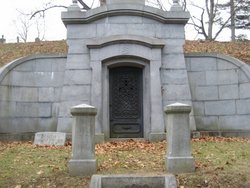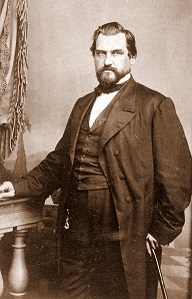Stanford Mausoleum (1795-1862) [Section 18 Lot 105]
Built for parents of railroad magnate Leland Stanford, co-founder of Stanford University, aided in westward migration, the creation of the Albany – Schenectady Turnpike, the creation of the Hudson – Mohawk Railroad, co-owner of Central Pacific Railroad, Governor of California, U.S. Senator from California

The Appalachian Mountains prohibited western migration before the nineteenth century with the only passable location along the Mohawk River in upstate New York. During the nineteenth century, that region, especially Albany, became an epicenter of transportation technological firsts. The Stanford family helped with that connectivity that fueled western migration in the United States.
In 1799, Lyman Stanford leased land from Stephen Van Rensselaer III, Patroon of the Manor of Rensselaerwyck in the Lisha Kill in present-day Colonie. Conveniently located halfway between Schenectady and Albany, the Stanford home was located along the original road between the two cities, known the Kings Highways, today Albany Street. Lyman and his wife, Elizabeth Roberts, had nine children. One son died as a child, and their only daughter, Jane, died in infancy. Their sons who grew into adulthood were Josiah, Charles, DeWitt, Asa Philip, Thomas, and Amasa Leland Stanford.
With the creation of the Albany Schenectady Turnpike in 1802, this established a straight road between the two cities “four rods wide with two rod wide roadbed; a rod being 16.5 feet survey measure.” Lyman, whose portion of the property later became the highway, worked as a contractor and opened the first tavern along the road next to the tollhouse on the western side. In total there were be 26 taverns along a 16 mile stretch of road which is known today as Central Avenue. Once completed, it quickly became the most heavily traveled commercial road in the United States, serving as a gateway to the west for the next 25 years. By 1810 there was a discussion of using the Mohawk River as another faster method of transportation, connecting the Hudson River to Lake Erie.
The Erie Canal became the largest public works project in the United States, despite the fact there was no federal backing. Proposed by Stephen Van Rensselaer III, who later served on the board, the project was referred to as “Clinton’s Ditch” after Governor DeWitt Clinton, and the skepticism they had on this project. With the opening of the canal in 1825, it was immediately was a success. Though unknown if anyone within the Stanford household worked on the construction, given their proximity of the tavern, they most likely served many workers on the canal.

In 1831, the first passenger train line was created parallel to the Albany Schenectady Turnpike. Known as the Hudson – Mohawk Railroad, Lyman’s son Josiah worked as a contractor where he graded the roadbed and supplied firewood for the trains.
In 1840, the family leased an additional 322 acres from, the last Patroon, Stephen Van Rensselaer IV. Located along the eastern side of the turnpike known as Elm Grove, the Stanford family opened another tavern as well as a boarding house.
With the discovery of gold in California at the end of the 1840s, five of the brothers moved out west. Leland Stanford stayed behind initially as he was studying law. The other brothers went back and forth between Albany and California, familiar with the operational needs of Albany during the days of the Erie Canal and Hudson-Mohawk Railroad, some opened up several stores which sold supplies to prospectors. Charles Stanford returned to Albany to source products and established a newspaper, The Schenectady Union. He later served in the New York Assembly and later the Senate.

Leland worked in Albany as a lawyer and married Jane Lathrop, daughter of Dyer Lathrop, Sergeant-At-Arms in the Assembly and Treasurer of the Albany Orphan Asylum, which he helped establish. Leland and Jane moved to Port Huron, Wisconsin, where he set up a law practice. However, a fire destroyed the building where his law practice and subsequently join his brothers out west. Jane initially stayed in Albany as Leland labeled San Francisco as “not yet a place for women,” but joined him in 1855 following the death of her father.
While in California, Leland’s political aspirations led him to unsuccessful runs for state treasurer, and later for governor on the newly established Republican Party line in 1859. In 1861 he ran again on the platform to keep California a part of the Union – as they waited a long time to become recognized as a state. Leland Stanford was elected the first Republican Governor in the state of California and served for two terms.
Leland was part of “The Big Four” which established the Central Pacific Railroad, their first locomotive was called Gov. Stanford. The Central Pacific later connected with the Union Pacific, in part thanks to President Lincoln’s Pacific Railroad Act of 1862. On May 10, 1869, the two railways connected in Promontory, Utah and Leland Stanford drove in the golden spike. Leland went on to serve as a stakeholder in the Southern Pacific and California & Oregon Railroad, founded the Pacific Mutual Life Insurance (Pacific Life), and be a part of the Oriental and Occidental Steamship Company. He also served in the U.S. Senate from California from 1885 – 1893.
Leland and Jane had one son, Leland Jr. in May of 1868. During a trip to Italy, Leland Jr. became sick with typhoid fever and died in 1884. Stricken with grief, they converted their 55,000-acre winery in Palo Alto and established the Leland Stanford, Jr. University. Frederic Law Olmsted was hired to landscape the campus.
Josiah found financial success in the vineyard business, Leland followed his lead before the death of his son. Thomas and DeWitt Stanford moved to New Zealand and establish hardware stores, which the family had done successfully in California.
Buried in the Stanford Mausoleum are Lyman and Elizabeth Stanford, four of their children, Josiah, his wife Elizabeth, DeWitt, Charles, and Jane. Also included are four of descendants of the Stanford family.